Author Archive
 Meh
Meh
No doubt you’ve seen the recent ARRL proposal to increase Technician HF privileges and the expected ensuing online debate over it. In general I’m not opposed to the proposal, however I find myself indifferent. As others have pontificated, it’s not much of a hurdle these days to upgrade to General to acquire more privileges. I was very supportive of the code test elimination and various changes over the years that have simplified licensing. However, to some extent I think we’re at a point of diminishing returns with benefits from licensing changes and privilege increases. There’s perhaps one specific area I see the ARRL-proposed changes increasing on air activity: FT8. If Techs are given HF digital privileges on lower bands, I suspect we’ll see a lot of Techs end up there, and stay there, like a lot of Techs do today with 2 meter repeaters, unfortunately. With new radio amateur recruiting, participation, and retention, where should our focus be, what are the real stumbling blocks, and where is the opportunity? It’s not privileges. In thinking about the ARRL proposal, I’m kind of left thinking, “Meh.”
We need to look where the bulk of amateur technology hobbyist activity is today. It’s the Maker movement. These are intelligent, innovative, and inquisitive people who would be a great asset in amateur radio. It’s often been said that amateur radio and its perhaps dated technology can’t compete with the Internet, Xboxes, and cell phones. That may apply to your grandkids, but with Makers it’s not an issue. Makers enjoy playing with retro technology, like Nixie tubes, for example. They like building stuff and experimenting. They also like cutting edge technology, like satellites. Amateur radio has the perfect blend of retro and modern technology, and it has the opportunity to take Makers beyond the typical Maker fare of microcontrollers, single board computers, 3D printing, and robotics. Unlike “preppers” coming into the hobby for a specific application for their own purposes, Makers will be active and contributing participants and arguably are more likely to advance the radio art, as amateur radio was intended to do. But we need to have a culture that welcomes them, on their turf, and their venues, not just ours.
The Maker movement is a potential goldmine for amateur radio, one that needs to tapped, right now. This goes beyond having an amateur radio display at a Maker Faire stocked with pamphlets. If we really want to increase participation and new licensee retention, we need to pull out all the stops and target this demographic with technology, exhibitions, publications, and venues that tie amateur radio into their curiosities, interests, and projects. We need to be seen as innovators, not preservationists or on air retirement communities. There needs to be cultural change within amateur radio. While more kilohertz for newcomers is nice, and fairly easy to implement, it’s not going to get sizable returns in participation and retention. Targeting Makers will.
This article originally appeared on Radio Artisan.
 Yet Another ARRL Opinion
Yet Another ARRL Opinion
For the first time in my amateur radio career, I’m beginning to look upon ARRL unfavorably. About 15 years ago after I acquired a lifetime subscription, my grandfather chastised me saying I’d eventually grow tired of the League and would regret my subscription. I’m sad to say I think that day may have come.
Over the years I’ve defended ARRL, in both in person conversations and online. ARRL attracts a lot of haters, often unfairly, for wrong reasons. For example, I’ve witnessed many hams hate ARRL, claiming they don’t like CW and worked to eliminate it, despite ARRL supporting code testing for Extra licensing in their FCC comments filings years ago, and offering daily code bulletins and practice over the air. Despite ARRL’s faults and shortcomings, amateur radio would not be where it is today, and perhaps not even exist, if it wasn’t for ARRL.
With the recent Code of Conduct and censure incident and the proposed voting and membership changes, I’m left with the impression of an organization that is closed, secretive, adverse to dissent, and focused on self-preservation. The Force of 50 debacle points to an organization eager to project to the public a disaster response “photo-op” image that neither the organization or the amateur radio service supports or deserves. Over the years I’ve personally seen other examples that support these two impressions but never dwelled on them as ARRL garnered my utmost respect as I felt that the League, despite its flaws, in general was taking amateur radio in the right direction. I no longer have that confidence in the organization.
While I could end my diatribe with the paragraph above, I really want to explore or ask, what is the solution to “fixing” ARRL? ARRL does a great job with publications and education, contesting, and lobbying the FCC. Does the large and seemingly complicated hierarchal governance structure really serve a purpose today? It appears that structure is geared more towards emergency communications initiatives than an effective membership feedback vehicle or advancing the radio art. Is this structure the problem and ARRL needs to be transformed into more of a flat, responsive, grass-roots kind of organization?
This article was originally published at Radio Artisan.
 Answers to Top 10 Field Day Questions
Answers to Top 10 Field Day Questions
Answers to the top 10 questions at Field Day, with questions omitted (and with 5 bonus answers):
15. Snakes.
14. Yes, I still hear the interference.
13. Behind that tree over there.
12. Because he knows his callsign and you don’t have to tell it to him three times.
11. Hit Return.
10. Hot.
9. Try rebooting it.
8. It doesn’t matter. It’s not up high enough to have any directivity.
7. Just say QSL.
6. Rain.
5. Yes, this frequency is in use.
4. It’s on the sign right above the rig.
3. I filled it up an hour ago. It’s good.
2. Yes, it’s done in the middle.
1. Hamburger.
This article was originally posted on Radio Artisan by a team of laptop-equipped squirrels.
 Irony
Irony
The FCC issued Report and Order 17-33 which creates two new bands for amateur radio, 472-479 kHz (630 meters) and 135.7-137.8 kHz (2,200 meters). As ARRL reported, it is a “big win” for amateur radio. I’ve been waiting in anticipation for the 630 meter band as it’s an old yet new frontier for us. With old Sol taking a bit of a nap for the past few years and perhaps for years or decades to come, lower frequencies are where we’re going to have to play for more fun.
There are a few caveats in using these bands. The FCC is requiring radio amateurs be at least 1 km from electric power transmission lines using Power Line Carrier (PLC) systems on those bands. PLC is a technology that uses low frequency signals on power lines to perform signaling and control functions, and often meter reading. Amateurs will have to notify the Utilities Technology Council (UTC) of station location prior to operating on 630 and 2200 meters. The UTC maintains an industry database for PLC operations.
Those who were around to experience the Broadband over Powerline (BPL) brouhaha around 2003 to 2005 may recall the UTC organization. At the time BPL was billed by proponents as the next big thing in broadband Internet. Amateur radio operators and ARRL argued vigorously against BPL, citing engineering and evidence that the HF signals on the power lines radiated into the ether and interfered with HF radio operations. The FCC turned a blind eye to the issue. Luckily market forces took out BPL as a viable broadband solution due to increasing bandwidth needs and numerous failed trials which uncovered its technical difficulties and business problems. PLC and BPL are cousins, with PLC operating below 500 khz and HF BPL operating from 1.8 to 30 Mhz.
The UTC, several electric utilities, and a handful of BPL equipment vendors at the time claimed that BPL didn’t interfere with HF radio operations. The explanations and claims baffled those of us experienced in wireless and RF engineering as it’s a fact that an unshielded conductor tens of wavelengths long, conducting RF signals, will radiate energy. The math and science supported this and measurements in the field provided real life evidence.
The UTC notes the following about PLC operation:
“This Activity is established as provided for in the FCC Rules and Regulations, Part 90.35(g) (47 C.F.R. ‘ 90.35(g)) relative to PLC operation in the 10-490 kHz band, and the NTIA Manual of Regulations and Procedures for Federal Radio Frequency Management, in Part 8.3, under the heading “Notifications in the Band 10-490 kHz,” (see 47 C.F.R., Chapter III). Electric utilities are allowed to use power line carrier (PLC) transmitters and receivers for control signals and information transmission in the 10-490 kHz band without obtaining a license from the [FCC]. However, PLC users are not protected from interference from licensed radio transmitters.”
Part 90.35(g) states that PLC operates under Part 15. With the distance separation and notification requirement for amateurs, the FCC has granted an unlicensed incidental radiating non-wireless service protection from a licensed wireless service. This was essentially the case with BPL in the early 2000s with an unworkable process for resolving interference issues, and interference complaints from amateurs living in trial site areas languishing for months with no action.
With this latest frequency allocation to amateur radio and requirements for protecting PLC operations, the tables are turned. It’s the electric utility industry, that once claimed power lines wouldn’t interact with wireless spectrum, that could potentially experience interference. Undoubtedly many FCC staffers involved in BPL in the past are no longer at the agency and the electric utility industry has forgotten about the BPL fiasco and fail to realize the irony of needing to protect PLC from wireless.
All this being said, I’m not attempting to downplay or criticize the allocation of the two new bands. I think it’s wonderful and I applaud ARRL’s success. However, I hope amateurs wishing to enjoy these bands aren’t prevented in doing so. While it’s unlikely a large number of amateurs will be excluded from operating due to PLC on high voltage transmission lines, PLC systems are used in meter reading applications in neighborhood power distribution systems. Hopefully the majority of systems do not operate in the new 630 and 2200 meter amateur bands and we can peacefully coexist, unlike what occurred with BPL.
 Study Finds Anomaly with Amateur Radio Operators
Study Finds Anomaly with Amateur Radio Operators
Results from a study published by University of California Berkeley in The Journal of Psychology found that amateur radio operators are 45% more likely than the general public to believe fake news articles or material with misleading or outright wrong claims. Researchers weren’t specifically studying amateur radio operators, but discovered the correlation by accident. The report noted:
“We tested over 15,000 adult subjects and recorded profiles of each person… the common attributes like age, race, ethnicity, etc. and also their likes, dislikes, hobbies, diets, habits, etc. We discovered a strong and unexpected correlation with those claiming to be amateur or “ham” radio operators after running all of the data through an analysis using a recently developed Reverse Polish Bayesian algorithm. The unexpected data correlation continues to have the research team puzzled and further study is warranted.”
There is currently no proven explanation for the correlation, however one plausible hypothesis has emerged, that exposure to high levels of radio frequency energy combined with very fatty diets and long periods of television viewing, with political and news programming exposure, causing the frontal cortex of the brain to rapidly atrophy. Researchers are struggling to reproduce the characteristics as lab mice either die or become very disinterested when exposed to the combination of factors, especially when frequencies in the 3.5 Mhz range are used in experiments.
This article originally appeared in Radio Artisan.
 Opportunity
Opportunity
A Maker Faire is a gathering of makers, essentially anyone who builds stuff such robots, electronics, clothes, tools, and equipment. It’s a very heterogeneous culture of people young and old, and includes do-it-youselfers (DIYs), teachers, engineers, scientists, hackers, and geeks. Think of Maker Faires as hamfests for makers. I attended Maker Faire New York City this year, my first Maker Faire. Think of Maker Faire NYC as the Dayton Hamvention of hamfests.

Any drive into The City, as we call it around here, is adventurous. This Faire was located at the New York Hall of Science (NYSCI) in Queens. You couldn’t park anywhere near the event, but there were numerous public mass transit options and two offsite parking areas with shuttle buses. We chose to park at Queens College and take the shuttle in.

The Faire consisted of mostly outdoor and some indoor exhibits, including ones that are part of NYSCI. I can’t do this event justice with the pictures I took, but there’s a pretty good slideshow on the Maker Faire site.

The most popular area, at least judging by the line of people awaiting to enter, was the Radio Shack booth, believe it or not. They had a build your own drone activity that people seemed to be falling all over themselves to get in. If only Radio Shack could get lines like this in their stores.
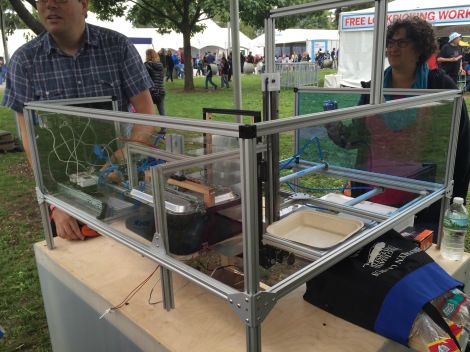
The coolest contraption in my humble opinion was a toasted cheese sandwich machine.
On the Faire map I was pleased to see an area labeled Amateur Radio. I donned my baseball cap embroidered with my callsign, normally reserved for the annual Dayton pilgrimage. The way the map was labeled, I expected to find a whole row of amateur radio stuff. There was one booth with two pop up canopies, manned by perhaps four hams. One side of the booth had a portable rig mounted in a plywood enclosure with some accessory boxes, perhaps a digital station. The other side of the booth had two tables with components and some kids soldering.
I want to be careful not to diminish or criticize the efforts of these amateurs and the organization they represented. After all, these guys made the effort and had an amateur radio booth (which is more than I can say for other organizations). But admittedly I was disappointed. I was really dismayed there weren’t more booths, especially considering the number of amateur radio operators there are in NYC, probably more in a five mile radius than I have in my entire rural county in PA. This is undoubtedly the largest gathering of people on the east coast who are interested in how things work, how to build things, and they’re smart people. Wireless for many makers is just a shield that you buy and plop on an Arduino or a USB dongle you plug into a Raspberry Pi. Amateur radio has so much to offer.
ARRL needs to have an exhibit at this event, in a big way, and not in the fashion they do at Dayton. There needs to be interactive hands-on displays by enthusiastic high energy amateurs. Not hardcore contesters or DXers, but amateurs who build stuff and can talk about practical applications that these makers can relate to and integrate into their existing projects and pursuits. Even CW displays would be interesting for this audience, it just needs to not be presented as a code proficiency course or a rite of passage, but something that is fun. Retro tech intrigues these people. Vacuum tubes would be considered cool by many makers, especially if you had some homebrew rigs built on plywood with filaments lit up and some RF meters dancing around or big old speakers crackling with the sounds of code or sideband coming from a direct conversion receiver. Fox hunts. This crowd would eat that up. Make a crystal radio with six components. There are plenty of high power AM stations in NYC that you can receive on a simple crystal radio. Kids holding Arrow antennas and listening to a satellite passing over. There’s just so much that could be done to showcase amateur radio at this and other Maker Faires, and draw people into the hobby. We’re missing a huge opportunity. Huge.
This article was originally posted on Radio Artisan.
 Dayton 2016
Dayton 2016
Another year, another Dayton in the history books. This was my third Hamvention trek, but this year was a bit different for me as I attended with my girlfriend. She somehow coaxed me into it, despite my concerns she would be bored out of her mind. However, we both had a great time.

Happy Hamventioners
I didn’t take as many pictures this year. At times I felt I could have recycled photos from the last two years and no one would notice. But there were some new sights to see….

Mannequintenna?
Yaesu was handing out truckloads of free “Yaesu 60th Anniversary” hats and other logo-adorned swag as usual. I was tempted to alter a hat to say “Yaesu FT-817 60th Anniversary” as the long-in-the-tooth rig continues to be offered with no modern update in sight. Ride that pony, Yaesu. As Jeff KE9V reported, no, the FT-891 is not an 817 replacement. It’s not an FT-897 replacement, either, so don’t ask. The FT-817 continues to be the Keith Richards of amateur radio rigs.
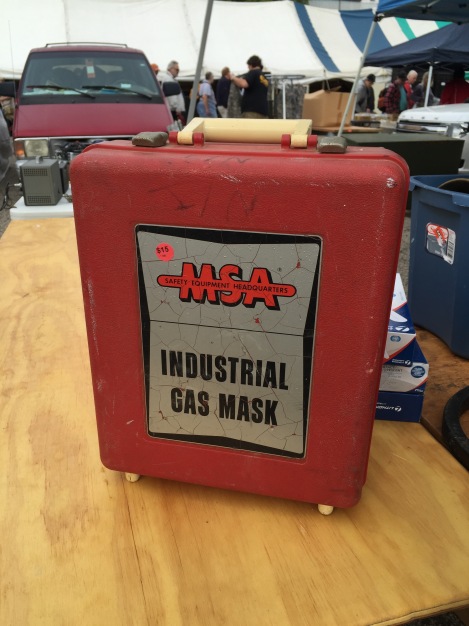
Required Equipment in Hara Arena Bathrooms
The Kenwood booth actually had visitors in contrast with last year when there were more tumbleweeds than attendees. Their newly announced super duper digital VHF/UHF rig undoubtedly attracted inquiries, though shame on their product line management people for not having it ready to sell at Dayton. In Kenwood’s defense, Yaesu’s new FT-891 wasn’t available for purchase, either.
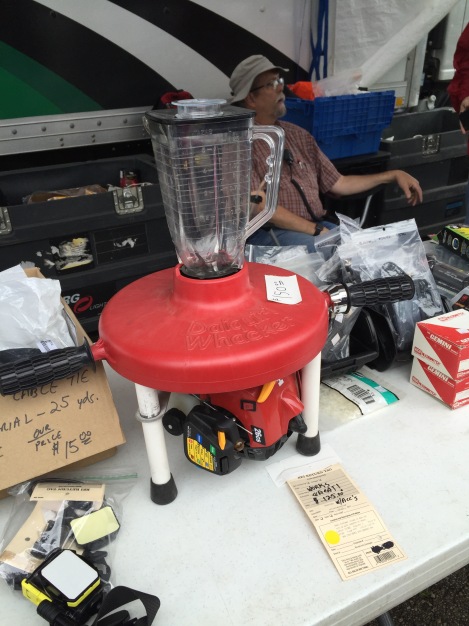
When All Else Fails, Make a Daiquiri
The crazy rig-selling train known as Elecraft continues barreling down the track. As everyone is undoubtedly well aware now, they released the KX2 at the Hamvention. No, this isn’t an X-rated version of the K2, or two K1s merged together, it’s a smaller KX3 without 6 meters or 2 meter add-on capability. This rig could have been a Yaesu FT-817 killer if it had VHF and UHF capability and reasonable pricing. 2 meter capability especially would have made sense to include considering this rig has the size and essentially the form factor of an HT. No doubt Elecraft will sell a ton of these rigs, but then again if they released a new version of the K1 packaged in a 55 gallon drum, they would sell them by the dump truck load.
I question how much longer Elecraft can keep up this sales momentum which I often feel is fueled by unreasonable customer loyalty. (Full disclosure: I own three Elecraft rigs.) Last year’s big announcement was the K3S, an improved K3, which teed off new K3 owners. This year’s release was a repackaged KX3. Elecraft seems to be innovating less and recycling products more.
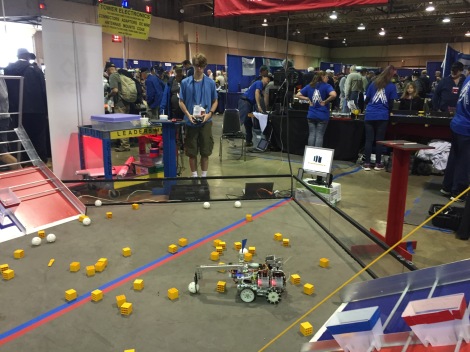
Domo Arigato, Mr. Roboto
I’m pleased to report there was a robot competition area and a local Makerspace representative booth. It’s good to see more Maker-oriented vendors and displays, which is really going to be the key to growing amateur radio after our older amateurs go silent key in the next decade. Hamvention folks, please, keep increasing this type of content.

Mendelson’s Flea Market Tent Family Planning Center
The flea market appeared to be the same size, with many long standing attendees selling the same junk, I mean, classic wares. I think there were less amplifiers for sale this year. That’s just a gut feeling, but I seem to recall many more amps last year. The same goes for rigs.
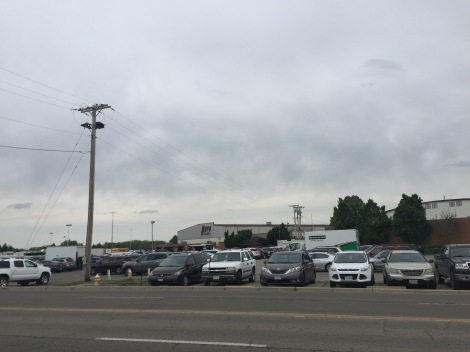
No Hamvention report would be complete without mentioning the condition of Hara Arena. Yes, good old Hara Arena. This is the final year for Hara. Seriously. I’m going on record and predicting it now. Really. This is it. Seriously. Last year’s announced multi-million dollar renovation plan fell through. I can’t imagine the facility can continue operating in its ever-worsening condition as it’s become a human safety nightmare that would cause any sane insurance company underwriter to run away screaming like their hair was on fire. Expect something to happen prior to the next Hamvention, either the occupancy permit being revoked, or the building turning into a pile a rubble on its own or by wrecking ball. Last year. Trust me. That being said, I left late afternoon Saturday sadly waving bye to Hara Arena thinking this may be the last year, like I was losing a dying friend. But the Hamvention is not Hara Arena, and Hara is not the Hamvention.











